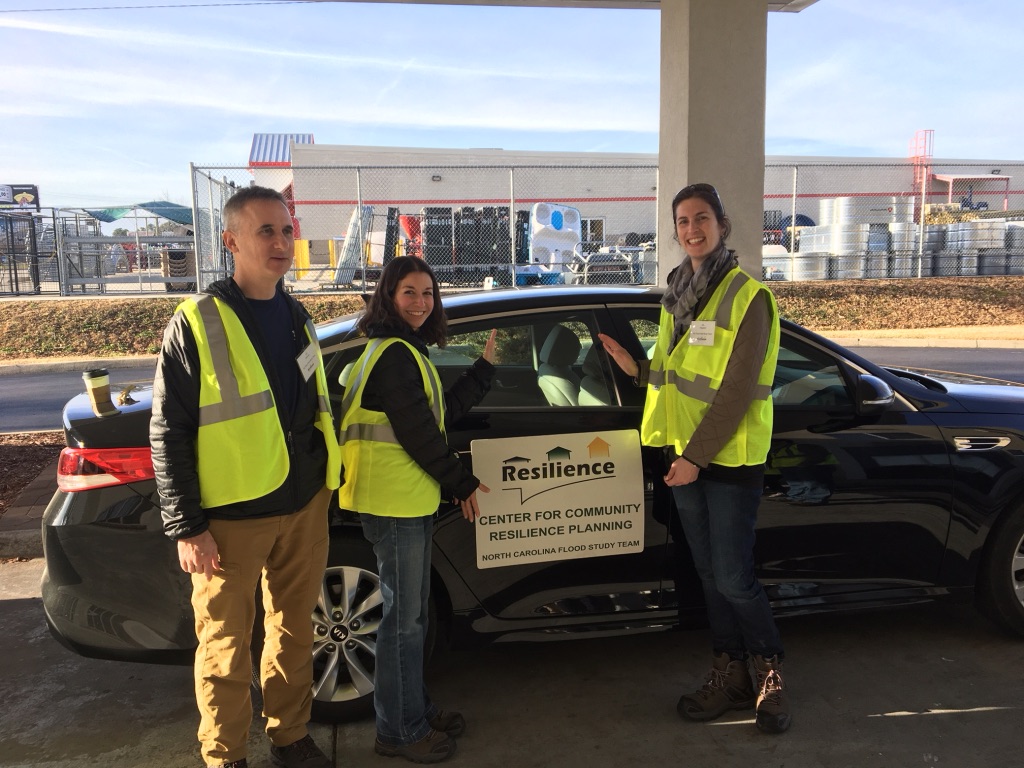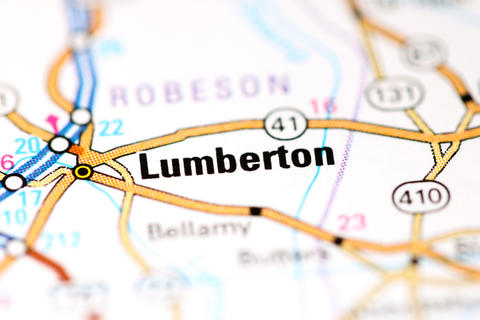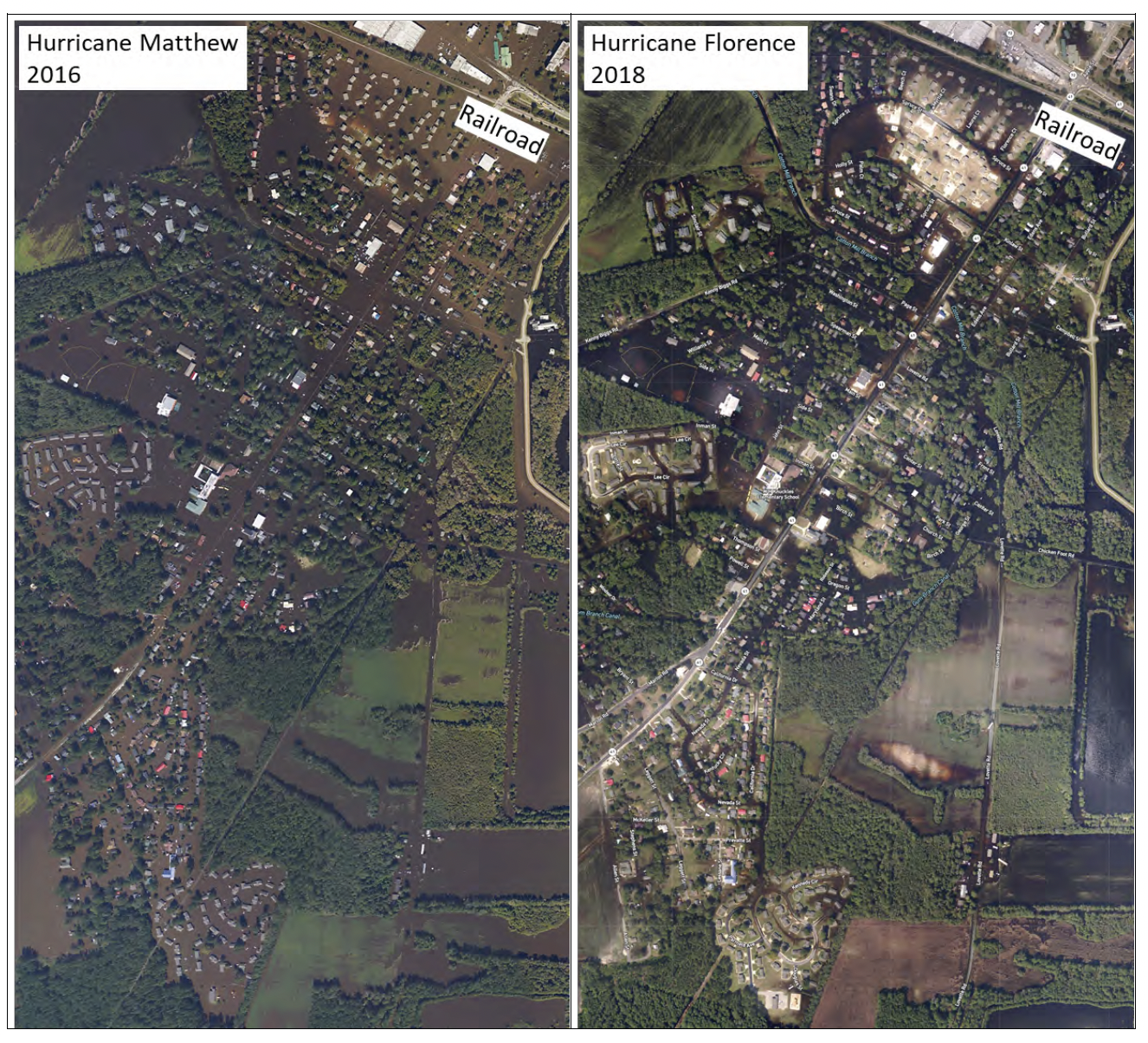Taking Measure
Just a Standard Blog
The Trials and Triumphs of a Small City’s Hurricane Recovery Could Help Other Communities Bounce Back

In September 2018, a North Carolina city’s long road to recovery from Hurricane Matthew two years earlier became even longer. Lumberton, a small but diverse city of 21,000 people, 96 kilometers (60 miles) inland from the coast, unfortunately found itself in Hurricane Florence’s sights. The Lumber River, which bisects the city, swelled greatly. The flooding damaged hundreds of buildings, causing many residents to abandon their homes.
NIST researchers, ourselves included, had first visited Lumberton in 2016, not long after Hurricane Matthew devastated the area. Because of this, a team of NIST researchers who study community resilience and disasters, together with researchers from the Center for Risk-Based Community Resilience Planning, a NIST-funded Center of Excellence, were watching the events of Hurricane Florence unfold with a close eye.
At the time, we were (and still are) conducting a long-term study of the city to uncover how a multitude of factors such as flooding damage, insurance coverage and demographics (e.g., race and age), among others, relate to impact, recovery and long-term resilience. Individual aspects of disaster recovery have been studied in the past, but they’re rarely tackled all at once. By piecing together this large and rather complex puzzle with engineering and social science expertise, we aim to glean insights that could help communities across the U.S.

After Florence struck, we quickly organized to send a team of engineers and other researchers to collect data on building damage in the city. We needed to get to North Carolina quickly because within a few weeks, or days even, valuable information can start to slip away. For example, high water marks on buildings and debris help to provide clues of where the water went, the extent of wind damage, and the impacts on homes and businesses.
As research social scientists, we were included in the deployment to Lumberton following Hurricane Florence to document the socioeconomic impacts of these hurricanes on Lumberton businesses and households. It was at times overwhelming to talk to business owners whom we remembered from our previous deployment and to see how their recovery from Hurricane Matthew had been slowed, or even reversed, by the recent impacts from Florence. Yet even with this difficult topic, so many people took time out to sit down to talk to us and participate in the survey. It was notable how many owners and managers seemed worried about their employees and their personal recovery in addition to the well-being of the workplace.
During our survey and interview process, it became clear that the intensified damage and interruption from Florence really exacerbated the difficulty of healing and planning for greater resilience following Matthew. But the grim circumstances gave us a chance to answer new questions about compounding disasters, an occurrence that is becoming increasingly frequent. Many people in Lumberton were more than willing to participate in the data collection because they wanted their stories to be shared. Furthermore, the people of Lumberton want other communities to learn from their experience and to be better prepared for events like Hurricanes Florence and Matthew.
Our surveys had high response rates in general. This was especially the case with small business owners, who responded at rates above 50%, which is exceptionally rare in these types of studies. We were able to engage with hundreds of owners we had visited on previous deployments and learn how their employees, customers, products, external support and other features of their businesses had been affected by the disasters over time.
We also had the opportunity to understand if any lessons learned from the experience with Hurricane Matthew made a difference to households and businesses as they faced the aftermath of Hurricane Florence. Our third report of this multiyear research effort suggests that was the case — many who had taken increased mitigation measures saw relatively reduced impacts.
It seemed that Lumberton had learned from Hurricane Matthew and was better prepared for the next flooding event. In Lumberton, they had started to develop and implement mitigation strategies that most definitely helped reduce the overall impact of Hurricane Florence.
Examples of these strategies for homes include elevating HVAC units and moving ductwork to the attic instead of the crawl space below the house. Residents also indicated that after Matthew they had created evacuation plans for the next flood event.
For businesses, impact mitigation strategies included risk assessments, emergency management drills, floodproofing, and securing a secondary storage area, among others. The most popular strategies included those that took relatively minimal monetary resources to implement, but did require time from staff, such as development of written emergency plans and actively monitoring weather warnings.

Despite the efforts of individuals and the local government in Lumberton, many are still struggling to recover from the combined impact of the two hurricanes. People really have tried to do what they can, with the resources they have, but there is a disconnect between the timing and availability of post-disaster support and the urgency of community recovery. If homes and businesses go too long without repairs, reoccupancy or a return to normal services and productivity, the community cannot recover to the pre-disaster condition. In the case of businesses, federal disaster assistance funds are often not an option due to complexity of eligibility. For residents who are eligible for federal funds, the lengthy process for obtaining the funds adds time to the recovery process.
If you look at Hurricane Florence in isolation, the impacts may not seem that bad. But when you look at these findings of our work that highlight the consequences of two hurricanes over time, it's a different story. The impacts of Hurricane Florence are amplified by the prior event, which Lumberton had not yet fully recovered from.
What has happened in Lumberton over the past several years demonstrates that disaster recovery, especially at the community level, is a complex, nonlinear process that can take much longer than many people might assume. To paint a full picture of what recovery looks like, long-term studies like ours are necessary. Individual insights from this work could help local officials and residents identify opportunities for improvement in their own communities — before and after such events.
One end goal of our interaction with Lumberton is to enable communities like it to use a complex computer modeling tool, the Interdependent Networked Community Resilience Modeling Environment (IN-CORE), which, along with technical assistance, could model their community and potential hazard events to show the impacts and how they might change if various policies were in place. For example, community leaders could examine the impacts of elevating more homes and businesses. This type of modeling supports an understanding of the trade-offs from social and economic perspectives.
Additionally, we continue to provide our findings to community decision makers in Lumberton and in North Carolina to support their understanding of the recovery process following Hurricanes Matthew and Florence.
Lumberton has helped NIST and the other researchers to learn a great deal and, in doing so, improves IN-CORE’s ability to represent reality. However, we are still a way off from capturing the city’s return to pre-Matthew conditions. The recovery process is still ongoing and has likely been complicated by the COVID-19 pandemic. NIST and the Center of Excellence continue to track Lumberton’s trials and triumphs along the way, which hold invaluable insights that could help other hurting communities facing similar challenges.
Reports from the Lumberton resilience study
The Lumberton, North Carolina Flood of 2016: A Community Resilience Focused Technical Investigation







Thanks Jennifer and Maria for an insightful blog. Appreciate your diligent leadership in seeking to understand this complex multi-layered and dynamic resiliency issue. The quality of your work and empathy for the stakeholders is evident. Looking forward to future posts.